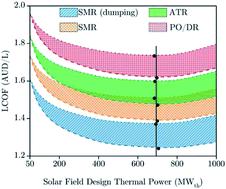当前位置:
X-MOL 学术
›
Sustain. Energy Fuels
›
论文详情
Our official English website, www.x-mol.net, welcomes your feedback! (Note: you will need to create a separate account there.)
Methanol fuel production from solar-assisted supercritical water gasification of algae: a techno-economic annual optimisation
Sustainable Energy & Fuels ( IF 5.6 ) Pub Date : 2021-08-16 , DOI: 10.1039/d1se00394a Alireza Rahbari 1 , Alec Shirazi 1 , John Pye 1
Sustainable Energy & Fuels ( IF 5.6 ) Pub Date : 2021-08-16 , DOI: 10.1039/d1se00394a Alireza Rahbari 1 , Alec Shirazi 1 , John Pye 1
Affiliation

|
Methanol synthesis offers a relatively fast transient response compared to other fuel synthesis technologies—a promising downstream alternative for solar-derived syngas. However, many non-intuitive design choices must be analysed to achieve an optimal techno-economic performance of this technology in the presence of variable solar energy. Using a combination of steady-state Aspen flowsheeting, dynamic simulation and techno-economic optimisation, this work presents the techno-economic performance of methanol production through solar-thermal supercritical water gasification (SCWG) of algae with three alternative methane reforming options. The syngas is conditioned for downstream use through either CO2 dumping or H2 addition. In a multi-objective optimisation, solar multiple and storage capacity are varied to minimise the levelised cost of fuel (LCOF) and maximise the capacity factor of the system. Results indicate that steam methane reforming (SMR) with CO2 dumping gives a minimum LCOF of ∼1.6 AUD per L. The lowest-cost reforming option changes if the cost of renewable H2 drops. Achieving high capacity factor (>98%) configurations requires large storage and causes LCOF to increase 4–5×. Scaling up the solar-thermal collector to 700 MWth yields LCOF reductions of ∼20% relative to the baseline 50 MWth scale, beyond which optical losses outweigh scaling benefits. Overall, the choice of methanol for downstream fuel synthesis appears to be beneficial due to its faster ramping and overall increased output compared to Fischer–Tropsch synthesis.
中文翻译:

从藻类的太阳能辅助超临界水气化生产甲醇燃料:技术经济年度优化
与其他燃料合成技术相比,甲醇合成提供了相对较快的瞬态响应,这是太阳能衍生合成气的一种有前途的下游替代方案。然而,必须分析许多非直观的设计选择,以在存在可变太阳能的情况下实现该技术的最佳技术经济性能。这项工作结合了稳态 Aspen 流程图、动态模拟和技术经济优化,展示了通过藻类的太阳能热超临界水气化 (SCWG) 和三种替代甲烷重整选项生产甲醇的技术经济性能。合成气通过 CO 2倾倒或 H 2 进行调节以供下游使用添加。在多目标优化中,太阳能倍数和存储容量是变化的,以最小化燃料的平准化成本 (LCOF) 并最大化系统的容量系数。结果表明,排放 CO 2 的蒸汽甲烷重整 (SMR)的最低 LCOF 约为每升 1.6 澳元。如果可再生 H 2的成本下降,则最低成本的重整选项会发生变化。实现高容量因数 (>98%) 的配置需要大容量存储并导致 LCOF 增加 4-5 倍。将太阳能集热器放大到 700 MW th可使 LCOF 相对于基线 50 MW th减少约 20%规模,超过此光损失超过规模效益。总体而言,与费-托合成相比,选择甲醇用于下游燃料合成似乎是有益的,因为它具有更快的升温速度和总体增加的产量。
更新日期:2021-09-01
中文翻译:

从藻类的太阳能辅助超临界水气化生产甲醇燃料:技术经济年度优化
与其他燃料合成技术相比,甲醇合成提供了相对较快的瞬态响应,这是太阳能衍生合成气的一种有前途的下游替代方案。然而,必须分析许多非直观的设计选择,以在存在可变太阳能的情况下实现该技术的最佳技术经济性能。这项工作结合了稳态 Aspen 流程图、动态模拟和技术经济优化,展示了通过藻类的太阳能热超临界水气化 (SCWG) 和三种替代甲烷重整选项生产甲醇的技术经济性能。合成气通过 CO 2倾倒或 H 2 进行调节以供下游使用添加。在多目标优化中,太阳能倍数和存储容量是变化的,以最小化燃料的平准化成本 (LCOF) 并最大化系统的容量系数。结果表明,排放 CO 2 的蒸汽甲烷重整 (SMR)的最低 LCOF 约为每升 1.6 澳元。如果可再生 H 2的成本下降,则最低成本的重整选项会发生变化。实现高容量因数 (>98%) 的配置需要大容量存储并导致 LCOF 增加 4-5 倍。将太阳能集热器放大到 700 MW th可使 LCOF 相对于基线 50 MW th减少约 20%规模,超过此光损失超过规模效益。总体而言,与费-托合成相比,选择甲醇用于下游燃料合成似乎是有益的,因为它具有更快的升温速度和总体增加的产量。


























 京公网安备 11010802027423号
京公网安备 11010802027423号